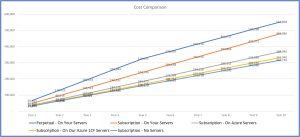Recently I was talking to a prospect that already has Dynamics NAV (the old name for Dynamics 365 Business Central) in his group of companies. He had approached CBIZ for some advice on how to expand its use to businesses with up to 50 users.
I decided to investigate what the best option was: move to the cloud or stay on-premise. The result surprised me – choosing the full cloud route is the cheapest way into Business Central. However, picking a licensing option isn’t as straightforward as it used to be.
There are two options for Dynamics 365 Business Central, and they require some thought. One choice is based on a technical discussion and the other is based on a company’s preference for Capital Expenditure versus Operational Expenses.
Rental Versus Purchase of Dynamics NAV
The graph below shows the comparative cost of having different deployment options with Dynamics 365 Business Central. This example is for 15 users, five of whom are team users. It includes an estimate for the hardware, people and IT infrastructure required to support those servers. Obviously, this can vary hugely – and individual mileage may vary – but hardware and support costs should not be underestimated.
As I started looking into the solution, I was surprised to find that the perpetual (ownership) model line never crossed over the others. I had expected the subscription (rental) values to exceed the perpetual within five years, but they do not. So, I doubled the IT spend and tripled the user count – you can see those figures below.
Again, the results showed the same thing, so I then went to test the boundaries: One and a half times the hardware costs of the above but with 60 full users (no team users). You can see those figures below, which are very similar to the other two charts.
From the results, and without overestimating the hardware costs, when it comes to the prospect making a decision on Dynamics 365 Business Central, we can see the best ROI is from the true SaaS (software as a service) cloud offering. This option is also easier to implement and manage.
Our specialised Azure offering, which gives you the ability to include a desktop, client, very low maintenance costs and direct customisations in the system), comes in second. We tailor the options and licence costs to each client, so if you’re considering making a change, get in touch today.
Should You Buy or Rent Dynamics 365 Business Central?
If you want to own your software, then there is only one licence choice – perpetual. This means you own the software and you pay the majority upfront (there is also an annual charge) and depreciate the asset as per your company rules. This is a capital expenditure approach and up until a couple of years ago, the only way you could buy Dynamics NAV.
However, you also need to give the same consideration to the hardware, and whether you’ll rent or own it. If you want to own your servers, back up solutions, operating systems, support contracts, and so on, you can do this.
There is then a choice over whether you have the servers on your own premises or in a third-party data centre. However, if you want to rent your hardware you have four options, which are listed below:
- Microsoft Azure Hosting
- On your own Azure account; or
- On our specialised Azure setup
- Microsoft’s Cloud (SaaS solution)
- Other third-party cloud infrastructure providers
Of the above choices, 1.b and 2 offer a solution where you do not need to look after your virtual machines. Option two is the true cloud solution offered (although 1.b is almost the same). This means you buy a monthly subscription from Microsoft, which includes everything required to run Dynamics 365 Business Central.
The other three options separate the licensing of the software from the hardware. To align with Microsoft descriptions, if you rent software you are on the subscription licence path, and if you want to own it you have a perpetual license.
You can mix which licence path you choose with your hardware approach, although it’s important to note that this is not available with option two; this is only a subscription path. Again, we can clarify the options on a call if you’d like to learn more.
Technical Considerations
Functionally, there is nothing to separate the choice of going on-premise (on your own servers), on a hosted server or on the cloud, as the software is the same. The only differences are around the client and the options available to extend the software and having access to the server and direct the database.
With the true Cloud (SaaS) version you can only use the web & mobile clients (which will be the only client in 2020, according to the roadmap). You can also only add additional functionality with plugins – extensions – which can be bought from the AppSource (Microsoft’s App Store) or bespoke solutions created by you or your partner.
The other deployment options, as listed above, allow you to also install clients and enables your partner to directly enhance the solution within its proprietary Development Environment (C/Side). The latter should only be needed in specific circumstances, as ideally, we should all be looking to develop within the modern Extensions approach.
The need to go on-premise should be discussed with your partner, as there are upsides and downsides to going this route. Give plenty of consideration to the options available to you before you make a decision.




